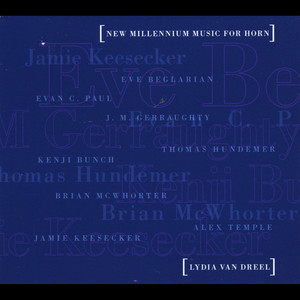
- 歌曲
- 时长
简介
This is a collection of pieces for horn written between 2004 and 2012, which I’ve had the great opportunity to perform. Each composer’s approach to the horn is unique and each points in new directions for writing and thinking about horn as a contemporary performance instrument. I’ve been a fan of Eve Beglarian’s music since the early 1990s, and her piece “Ein Horn” (2011), which I commissioned, is written for natural horn and electronics. The piece is inspired by a Rilke poem that Eve had been ruminatingon for more than ten years. In describing Ein Horn, Eve writes on her website, “Love creates a space in which the impossible becomes real: how amazing is that?!” This piece was written at the Hermitage in Florida during a residency in 2011. Jamie Keesecker’s “The Impetuous Winds” (2008) was written as part of a collaborative composition workshop at the University of Oregon. QUADRE: The Voice of Four Horns read works by (then) students and we liked Jamie’s piece so much, we included it on our 2011 CD, “Our Time”. I’ve enjoyed performing this piece quite a bit, so I’ve included it in this collection as well. J.M. Gerraughty’s Trio for Horn, Violin and Piano, mvt. 1 (2009) reflects his love of the great romantics and his penchant for massive sonic events in his compositions. While he was a graduate student in composition at the University of Oregon, I asked Jason to write a piece for horn, violin, and piano in the tradition of Brahms and Ligeti. This bold piece is the glorious result. Kenji Bunch’s “Shout Chorus” (2006) was commissioned by the Bravo! Vail Valley Music Festival in 2006, and premiered by the Imani Winds in Vail, CO in July of that year. Kenji describes his music as follows: “With the emergence of a New American Cuisine in the culinary world, we see a renewed interest in honoring and elevating classic dishes of American regional cuisine by combining locally sourced ingredients, the techniques of classical European traditions, and the artistic imagination unique to each chef. In this spirit, with my music I draw inspiration from the locally sourced sounds I hear around me and the uniquely American art forms they come from, then combine these elements with the techniques of my classical training into my own personal vocabulary that strives to honor our past while suggesting new possibilities for the future.” Shout Chorus, for wind quintet, thoroughly exemplifies this aesthetic and the Oregon Wind Quintet is thrilled to present the first recording of this joyous work. Alex Temple’s “Thick Line” (2012) was originally written for Eclipse Wind Trio to play at the Fresh Inc Festival. It is scored for 3 or more indeterminate wind or brass players. On her website, Alex writes, “All the musicians read from the same score, which specifies rhythms, dynamics, contours and character markings, but not pitches. Each note thus blurs into a rich harmony, and those rich harmonies move up and down in parallel, as if the piece's melodic line were drawn with a thick piece of charcoal rather than a fine-tipped pencil.” Thomas Hundemer’s “Gently Weep” (2004), was originally commissioned by natural hornist Kristine Coreil. The piece can be performed with or without digital delay, or performed with multiple hornists spatially situated around a room with a time-delay. The piece's title occurred to the composer as it was being finished: He discovered that one of his musical motifs resembled "While My Guitar Gently Weeps," by the Beatles. Evan C. Paul writes: “STRIA” (2012) "is the most recent in a series of works for brass quartets. It functions as a sister work to Asterism for four trumpets, paralleling its form, a number of its melodic fragments, and its geological allusions: “stria” is from the Latin word for “stripe” or “streak,” and we still see a reference to this in the English word “striations.” The title is a reference to the geological phenomena of contrasting series of streaks that run through rock. The quartet explores sharp dissonances and an event-based approach to gesture and arrival. After a brief opening where the presence of the horns come into focus through isolated staccato notes, the horns create compound gestures that variously veer together into acerbic clusters and explode apart into wide-flung sonorities. These are offset by small melodic fragments, paralleling a similar concept in Asterism (the word “asterism” is also a reference to star constellations). Sudden quartal, homophonic climaxes and fanfares bookend the slower B section, which creates a single melodic concept divided among the horns. This section gives rise to the creation of a nine-note row, which perseveres in various forms through the return of the A section and becomes the material for a slow, canonic coda. The horns express a severely compressed cycle of the major building blocks of the work and erupt into an explosive finish.” On this recording, I performed all the tracks, which were then deftly assembled by Lance Miller and Brian McWhorter in the editing room. Brian McWhorter’s “Build” (2010), commissioned by the Machine Project for the Little William Theater Festival of New Music at the Hammer Museum (UCLA) for Doug Tornquist and Luke Storm, is scored as a set of directives for a piece of performance art, e.g. (“…certainly don’t admit with your body language that this is your favorite piece on the show…”, “get lost in your sound and the unconventional lexicon you’re using”, “[ossia: bring a present for your duo partner]”). On this recording, we did a number of takes following the directives. Brian also conducted us through a few of the takes, yielding some hilarious results. The final shaping of BUILD is largely due to Brian’s sheer joy and whimsy in music and irreverence, and his incredible skill as a producer and editor. Also, I couldn’t ask for a better improvisation partner than hornist Kelsi McGlothin, featured here.

